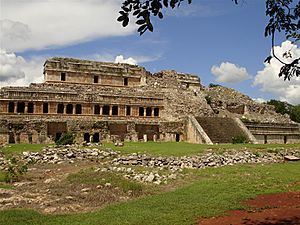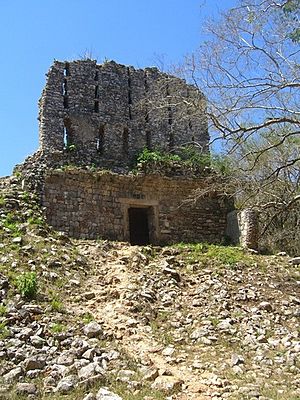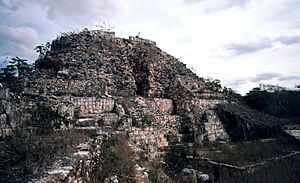Sayil facts for kids
Sayil is an ancient Maya city. It is an archaeological site located in the Mexican state of Yucatán. Sayil is in the southwest part of the state, south of Uxmal. In 1996, Sayil became a UNESCO World Heritage Site along with Uxmal.
Sayil was a very important city for a short time. This was during the Terminal Classic period. Some damaged monuments suggest that Sayil had its own royal family. Wealth among families might have come from controlling the best farming lands.
Contents
Where is Sayil?
The site is in the karst limestone hills. This area is called the Puuc region. It is in the northern part of the Yucatan Peninsula.
Sayil is about 7 kilometres (4.3 mi) south of Kabah. Kabah is another ancient Puuc site. Sayil is also 5 kilometres (3.1 mi) from Xlapak and 5 kilometres (3.1 mi) from Labna. The city was built in a small valley. This valley is surrounded by low, steep hills.
The Puuc region has clear wet and dry seasons. There is almost no surface water here. This is because the limestone rock lets water soak through easily.
Who Lived in Sayil?
People first settled in Sayil around 800 AD. This was during the Late Classic Period. It might have been settled by small groups of Chontal warriors. The city grew the most around 900 AD. At its peak, Sayil covered about 5 square kilometers. About 10,000 people lived in the city itself. Another 5,000 to 7,000 people lived nearby.
When the city was at its largest, many people lived there. They grew crops in gardens and fields. These were among their homes. They used special underground tanks called chultuns to store rainwater. They also farmed in valleys far away. Other nearby towns probably sent food to Sayil too.
Sayil started to decline around 950 AD. The city was empty by about 1000 AD. This quick growth and decline was common in the Puuc region.
Archaeologists have studied 2.4 square kilometers of the site. They found about 220 buildings per square kilometer. Experts guess that 8,000 to 10,000 people lived in the city. This was spread over about 3.5 square kilometers. Other guesses, based on the number of chultuns, suggest 5,000 to 10,000 people. Both numbers are for the time when Sayil had the most people.
Leadership in Sayil was spread out. Different people were in charge of politics, money, society, and religion. For example, the size of buildings showed how wealthy people were. Stone pillars called "altars" showed political leaders. Special pottery showed religious leaders. Rare pottery showed social leaders.
Smaller sites near Sayil, like Sodzil, Xcavil de Yaxche, and Xkanabi, might have been part of Sayil's control.
Sayil's History
Sayil and other Puuc sites are important. They show how Maya culture changed. This was from the Classic Period to the Postclassic period. Sayil had a short but important time of growth. This happened after the Classic Maya collapse. The collapse caused many Maya lowlands to become empty.
Sayil might have grown from an older settlement called Chac II. Chac II was a small site in the same valley. It was settled as early as the 5th century AD. Dating methods show Sayil started fairly early in the Terminal Classic period. Pottery found at the Palace shows trade with the Petén region in Guatemala. This was during the Late Classic. Obsidian tools from Guatemala also show that old trade routes were used. This was when the big buildings at Sayil were made. Sayil started in the Late Classic, but it grew fastest in the Terminal Classic.
Some buildings show that people lived in Sayil even after the main city was left. This was a short time of people still living in the homes at Sayil. The main time people lived here was from 800 to 950 AD. This was the Late to Terminal Classic period.
How Sayil Was Found Again
John Lloyd Stephens and Frederick Catherwood were the first to tell the outside world about Sayil. They explored the site in 1841. They wrote a book in 1843 called Incidents of Travel in Yucatán. In the book, they called the site "Zayi".
The Sayil Site
Studying the Site
The Mexican Instituto Nacional de Antropología e Historia (INAH) worked to restore Sayil. This was in the first half of the 1900s. Archaeologists have mapped 3.5 square kilometers of the city center.
From 1983 to 1988, Jeremy Sabloff and Gair Tourtellot studied Sayil. They mapped buildings and the land. They also dug in homes and collected items from the surface.
From 1990 to 1992, Michael P. Smyth and Christopher D. Dore collected items. They found almost 30,000 pieces of pottery. They also found 155 stone tools. Most of these tools were made of chert. Some were made of basalt, obsidian, and limestone. The obsidian came from a place called El Chayal in Guatemala. This place was far away. It traded obsidian all over Central America.
What Sayil Looks Like
The site is built along a sacbe, which is a raised road. This road runs from north to south. The Great Palace is at the north end of the road. It is the biggest and most famous building at Sayil.
The Great Palace has a front that is 85 meters long. It is built on two platforms, making it look like it has three stories. Rooms are arranged around all four sides of each platform. The top platform has a long building with one row of rooms. The palace was built over time in the Terminal Classic. Wings were added, and platforms were designed. These were filled with stones and mortar to make them strong. The palace has a main staircase on the south side. This staircase leads to the upper parts of the building.
The first and second levels of the Great Palace have older buildings underneath them. These were taken down to build the palace we see today. The first level sits on an older building from the Late Classic period.
The sacbe goes south from the Great Palace. It leads to a group of buildings about 350 metres (1,150 ft) away. These buildings have many rooms. The building called El Mirador is in this group. It is a damaged temple pyramid with a tall crest on top. It faces south. It has a two-room building on top of an older structure, but it has partly fallen down.
Another sacbe goes from the Mirador Complex. It runs 200 metres (660 ft) southeast, then turns south. It continues to a large group of buildings. This group includes a ballcourt and several palaces. These are about 2 kilometres (1.2 mi) south of the main palace. About halfway along this sacbe, there is a small platform. On this platform, archaeologists found the remains of eight stone slabs called stelae. They also found seven plain altars. This platform is common at major sites in the eastern Puuc region.
The remains of other buildings are on both sides of the sacbe system. Most are to the west. Structure 3B1 has a doorway inside with carvings of hieroglyphs. Structure 4B1 has a main doorway with two carved pillars. These pillars support carved tops and three carved stone beams. Pillars in the Puuc style are seen often at Sayil.
Another group of palaces is on a hilltop north of the sacbe system. They look over the main part of the site.
Homes at Sayil were mostly made of materials that do not last, like wood and thatch. They were built on stone foundations. Some of these foundations have been dug up by archaeologists.
The site is managed by the Instituto Nacional de Antropología e Historia (INAH). It is open for visitors to explore.
Chac II
Chac II is a small site about 2 kilometres (1.2 mi) from the Great Palace. It is in the northwest part of the Sayil Valley. In the Terminal Classic period, Chac II was part of the larger Sayil city. However, Chac II is older than Sayil. Different dating methods show that Chac II was important in the Early to Middle Classic periods. It traded with the big city of Teotihuacan in the distant Valley of Mexico. Chac II probably controlled the Sayil Valley until the end of the Late Classic. It is possible that Sayil was started by the leaders of Chac II. Sayil then became a huge city that grew from the older site.
Ancient Monuments
Several monuments have been dated by Tatiana Proskouriakoff. She used their carving styles. Stela 6 is from about 810 AD. Stela 3 and Stela 5 are from a bit later in the 9th century. The stelae at Sayil are in the Classic Maya style. They show important people who were probably rulers of the city. However, power in Sayil was likely shared among different leaders.
See also
 In Spanish: Sayil para niños
In Spanish: Sayil para niños





